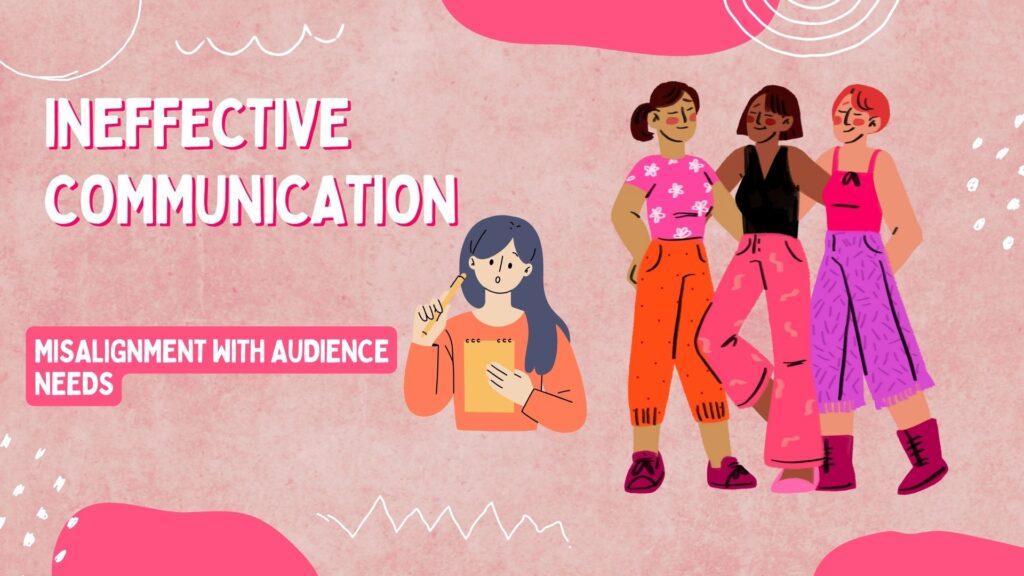Ineffective Communication: The Silent Killer of Marketing Efforts
In the world of marketing, where capturing attention and driving action are paramount, effective communication reigns supreme. However, when communication falls short, it can become the silent killer of your marketing efforts, rendering all your creative endeavors and strategic planning ineffective. Here are some key reasons why ineffective communication can cripple your marketing efforts:
1. Misalignment with Audience Needs:

Without a deep understanding of your target audience’s needs, desires, and pain points, your communication becomes nothing more than noise. You may be crafting beautiful visuals and using clever wordplay, but if your message fails to resonate with your audience’s specific problems and aspirations, it will fall flat.
2. Lack of Emotional Connection: (Ineffective Communication)
Effective marketing goes beyond simply conveying information. It aims to connect with the audience on an emotional level, evoking feelings of trust, empathy, and excitement. Ineffective communication often lacks the emotional depth to engage the audience, leaving them indifferent and unmoved.
3. Confusing or Incoherent Messaging:
When your message is unclear, confusing, or riddled with inconsistencies, it creates frustration and disengagement among your audience. They may struggle to understand what you are offering or the benefits your product or service provides, ultimately leading them to abandon their interest.
4. Failure to Address Pain Points:
A successful marketing message addresses the specific pain points and challenges faced by your target audience. By failing to identify and address these pain points, your communication loses its relevance and fails to demonstrate how your product or service can offer a solution.
5. Inconsistent Brand Voice
Maintaining a consistent brand voice across all communication channels is crucial for building brand recognition and establishing trust. Ineffective communication often suffers from inconsistency in tone, language, and messaging, creating confusion and hindering brand identity development.
The Consequences of Ineffective Communication
The consequences of ineffective communication in marketing can be severe and far-reaching. Some potential downsides include:
- Reduced brand awareness and recognition
- Lower engagement and conversions
- Damaged brand reputation
- Increased customer churn
- Wasted marketing resources
Strategies for Effective Communication:
To avoid the pitfalls of ineffective communication and ensure your marketing efforts reach their full potential, consider these strategies:
- Conduct thorough audience research: Gain a deep understanding of your target audience’s demographics, psychographics, and buying behaviors.
- Define your brand voice: Establish a consistent and authentic voice that guides all your communication efforts.
- Focus on benefits, not features: Highlight how your product or service solves specific problems and addresses audience pain points.
- Use clear and concise language: Avoid jargon and technical terms that your audience may not understand.
- Tell compelling stories: Utilize storytelling to connect with your audience on an emotional level and make your message memorable.
- Test and refine your messaging: Continuously test and refine your communication based on audience feedback and data-driven insights.
Conclusion: Ineffective Communication
Effective communication is the cornerstone of successful marketing. By investing time and effort in understanding your audience, crafting compelling messages, and ensuring consistency across all touchpoints, you can overcome the silent killer of ineffective communication and unlock the true potential of your marketing efforts. Remember, in the competitive world of marketing, clear and impactful communication is not just a suggestion, it’s a necessity for achieving sustainable success.
But it’s not enough to simply send information hurtling into the void. As HelpGuide reminds us, effective communication is a two-way street (https://www.helpguide.org/articles/relationships-communication/effective-communication.htm). It’s about understanding the unspoken language of emotions and intentions, not just the surface-level words. It’s about truly listening, not just waiting for your turn to talk. It’s about creating a safe space where vulnerability and authenticity can thrive, where miscommunication melts away in the warm glow of mutual understanding. Only then can our messages truly land, fostering deeper connections, stronger relationships, and a ripple effect of positive change that extends far beyond the initial exchange
The 5 Biggest Marketing Mistakes to Avoid